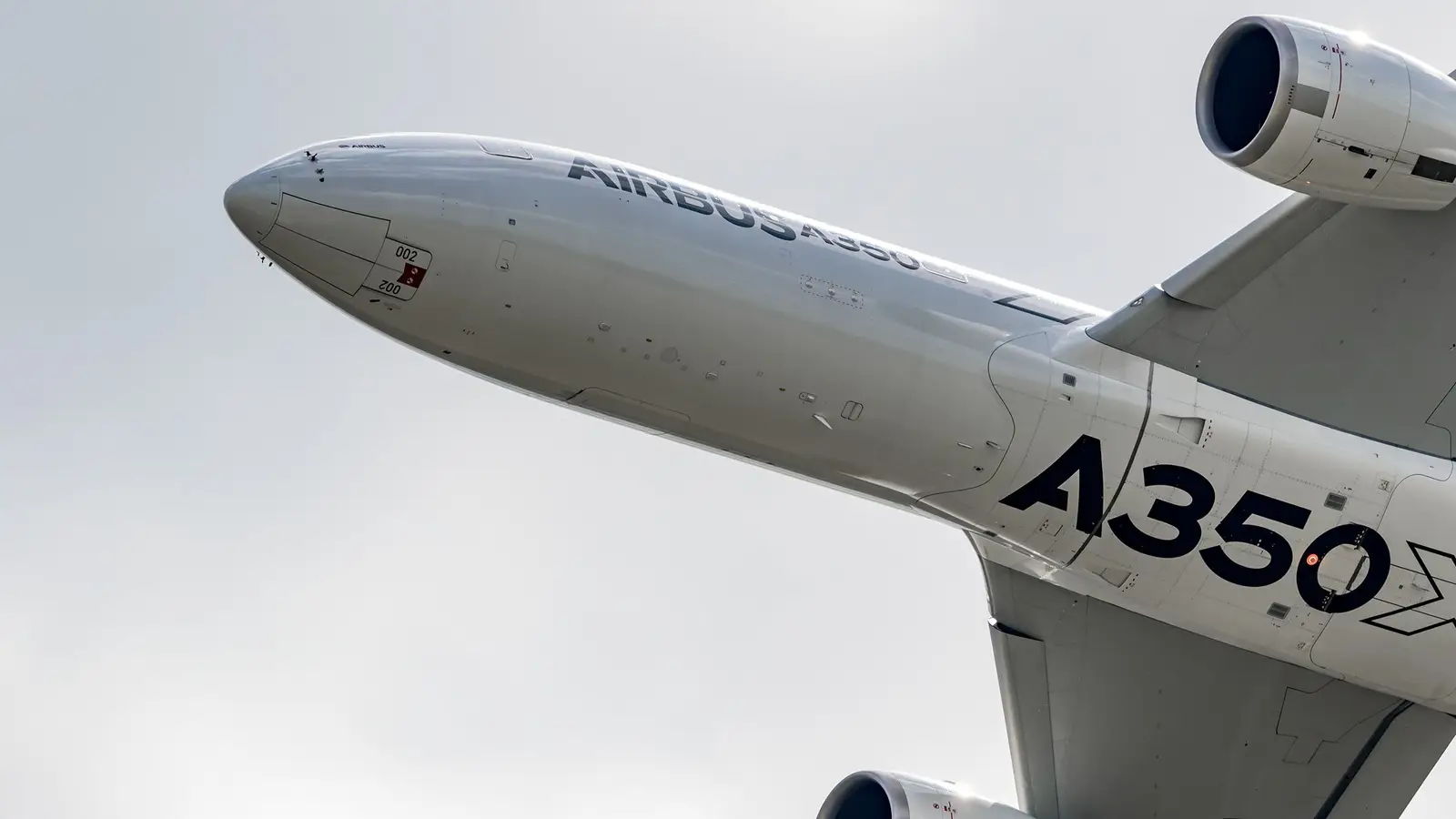
Since its introduction, the Airbus A350 XWB (Xtra Wide Body) has been widely regarded as one of the leaders in twin-aisle cabin comfort. However, Boeing’s next-generation 777X is set to challenge that status. With changes in fuselage design, cabin layout, and materials, the Boeing 777X promises a wider internal cabin than the A350, which means the A350 may no longer be the widest single-deck widebody in terms of passenger cabin space.
Widebody aircraft are judged not just by their length or wingspan, but also by their internal cabin width, which impacts seat configurations, aisle and armrest width, window size, and overall passenger comfort. As airlines demand more space and amenities to attract premium and economy customers alike, even modest gains in cabin width can matter a lot.
How The A350 Set A Standard & The 777X Will Surpass It
When the A350 XWB was developed, one of its key selling points was the width of its cabin compared to earlier Airbus jets and many of its competitors. The ‘XWB’ tag reflects its extra-widebody, and Airbus designed a fuselage cross-section that provides good usable internal width, sidewall geometry, and seating flexibility that passengers praise.
The A350 has an internal cabin width of about 5.61 meters (≈ 18.4 feet) between wall panels, depending on how measurements are taken (at armrest level, sidewall curvature, or insulation). This allows for quite comfortable economy seating (most airlines use a 3-3-3 layout in economy class on the A350) and, in many cases, more generous widths in premium cabins. However, the Boeing 777X has been designed with cabin width as a key differentiator.
Boeing claims that its new 777X cabin is four inches wider than the 777-300ER (which itself is already wider than the A350 in many respects). Through ‘sculpted’ sidewalls, thinner walls/insulation, and revised interior framing, Boeing has squeezed more usable cabin width while keeping the external fuselage largely similar. Thus, the 777X will offer about 5.97 meters (≈ 19.6 feet) of internal cabin width, according to Runway Girl Network.
How The 777X Achieves The Width Gain
To understand how Boeing has managed to outdo Airbus (at least in cabin width), it helps to look at the design decisions behind the 777X cabin. The starting point is the fuselage: the 777X retains much of the outer dimensions of the classic 777 family, but modifies internal structure, insulation, wall thickness, and sidewall framing to reclaim space, as described by Aircraft Interiors International.
For example, Boeing claims that by thinning sidewall insulation and adopting new sidewall designs, it has added several inches of usable cabin width. The four inches wider than the current Boeing 777-300ER number often cited refers not to the exterior fuselage width (which remains roughly the same) but to the usable internal cabin cross-section.
The way the extra width is used will depend heavily on airline cabin choices: wider aisles, larger armrests, more shoulder room, or more seat width versus more seats per row. For airlines seeking maximum capacity, they might still squeeze 10 across in economy, but the 777X offers more flexibility to make that 10-abreast more comfortable than the equivalent 10-abreast in older 777s or even the A350.
Cabin Experience Differences Beyond Width
Of course, cabin width is only one axis of passenger comfort. Cabin height, ceiling design, window placement and size, cabin altitude and humidity, noise suppression, and air circulation all matter too. Both Airbus and Boeing have made efforts in these other dimensions. Modern ergonomics is about a wide plus well-designed cabin. For the A350, features such as larger overhead bins, high ceilings, lighting design, and its composite fuselage help deliver comfort.
Airbus has also updated the A350 cabin through the New Passenger Standard variant to include improvements in cabin layout, weight, and MTOW. Among other changes, these aim to slightly widen or at least make better use of cabin space, according to another Aircraft Interiors International article. For example, Airbus has been planning or implementing interior tweaks to allow 10-abreast seating in some configurations on the A350 NPS, though at reduced seat width.
In summary, Boeing isn’t adding width for width’s sake or to set world records. Rather, its design work indicates that many of the comfort improvements are being packaged with that extra cabin width. Depending on how airlines configure their 777X, passengers could see noticeably more comfort in economy class compared to many existing A350s, especially those with tighter layouts.
What The Wider Cabin Means In Practice
So what does this cabin width ‘arms race’ mean for real passengers, and for airlines? For airlines, having more internal width provides flexibility, as they can choose to seat more passengers per row or have fewer seats with greater comfort. They can also adjust aisle width, offer premium economy with decent shoulder space, or offer larger middle seats. The wider cabin allows airlines to tailor the layout more generously or compactly.
From data and mockups, Boeing has shown that in a 10-abreast economy layout, the 777X can support ≈ 18-inch seat widths in certain configurations, which are larger than some of the tighter 10-abreast layouts on the A350 (which may reduce seat width to ~17 inches or less, depending on the airline). Also, important: aisle width and armrest width can suffer if seat count is maximized, so airlines that want to preserve comfort will need to sacrifice something.
For passengers, that can mean more comfort: less ‘squeezing’ at the shoulder/hip, possibly wider armrests, better window views, more space for carry-on bins, and less feeling of confinement. Also, for airlines, more efficient use of fuselage volume and better cabin appeal in competitive markets. The downside may be slightly higher weight or complexity (thinner walls may cost more, sidewall design may be more complex), but Boeing seems to judge that the trade-offs are worth it.
Limitations, Trade-Offs & Why The A350 Still Has Strong Points
Though the 777X promises more cabin width, that does not automatically make every 777X more comfortable than every A350. Layout choices matter a great deal, and they largely depend on the airline. An A350 with a more generous layout (wider aisles, fewer seats per row, and good window design) may outperform a packed 777X. Also, comfort factors beyond width (noise, humidity, and lighting) are equally crucial.
Airbus has also continually improved the A350. Its New Passenger Standard cabin aims to tweak weight, MTOW, cabin amenities, and possibly maximize usable width or space in clever aircraft-interior ways. In markets where operational costs, runway length, and fuel efficiency matter more than maximum seat density, the A350 remains a strong competitor.
Another limitation is that aircraft performance is a composite of many metrics. A slightly wider cabin adds weight and structural complexity, which might affect insulation, thermal management, and soundproofing. Airbus’s composite fuselage and other design strengths (fuel efficiency, current in-service reliability, operator familiarity) mean the A350 still has strong appeal.
Furthermore, for airlines that already have many A350s, changing configurations is expensive. As such, even as the 777X overtakes in width, the A350 will remain in many fleets with premium and comfortable settings.
Broader Implications & The Bottom Line
In today’s widebody market, even small dimensional differences become powerful marketing tools. Boeing’s decision to promote the 777X as ‘wider than the competition’ directly challenges Airbus’s A350, giving airlines new branding angles, from promising more comfortable economy seating to showcasing premium cabins with extra space and larger windows. For passengers, however, the impact of cabin width goes beyond numbers.
Wider aisles, larger bins, and broader seats can reduce fatigue on long-haul flights, while lighting, humidity, noise, and window design further shape the onboard experience. The 777X combines these features into a cohesive passenger offering, but how much travelers benefit will ultimately depend on whether airlines use the extra width for comfort or for squeezing in more seats.
At a market level, the 777X’s advantage could reshape fleet strategies, with some carriers prioritizing its size and economics while others stick to the A350 for its proven efficiency and earlier availability. The A350 is no longer assured of being the world’s widest widebody, but comfort depends on far more than raw cabin width. The true test will come once the 777X enters service and airlines reveal how they configure it, and how passengers respond in practice.



